| |
1.5" C:B ratio - test day
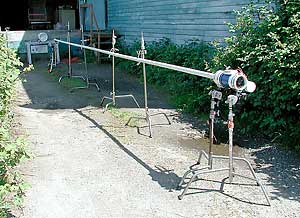
|
The 30 foot barrel was suspended with rope loops which were attached to heavy duty stands. Aligning a barrel of this length with a chronograph and a small backstop took some time but was not impossible. Looking through the endcap and barrel from the rear of the launcher confirmed there were no kinks or bends. The loops of rope allowed the barrel to spin freely for ammo changes. A gasket slug was fired first and surprisingly it exited the barrel at speeds as high as 180 MPH during the first 6 shot string. Would a spud, with its' much higher friction, exit the same barrel with such velocity? We had 30' of conduit to use as a pushrod if it didn't.
|
|
The spuds were breech loaded with the aid of a slug cutter. A mini pushrod with a T fitting stopper loaded the spud in the same position each time which was set up to correlate with the position of the gasket slugs.
|
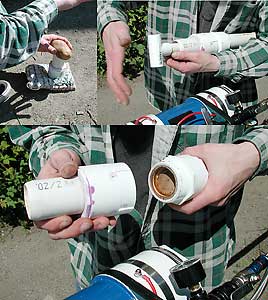
|
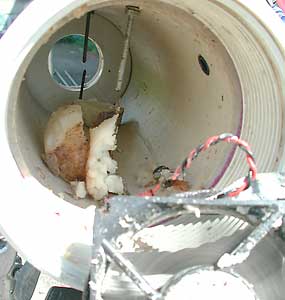
|
This is what happened on that first shot with spuds and a 30' barrel. The spud did not exit the barrel, instead, it made it part of the way down then ran out of energy. The vacuum created behind the spud in the barrel caused it to recoil back into the chamber. The potato slammed against the main spark electrodes bending them backwards and slicing the spud into pieces. Starch and potato bits covered the 80mm fan but did not break it . The electrodes were bent back into place and the chamber cleaned up for the next attempt.
|
|
Not wanting to give up after one shot, it was decided that the inner bevel of the knife edge would be reduced to lower the spuds friction. An on the spot modification left the slug cutter with just a slight inside taper and a long outer taper to achieve a thin profile knife edge.
|
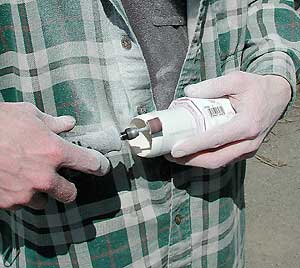
|
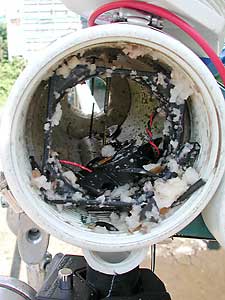
|
Apparently, the modification almost worked. The second shot at 30' was similar to the first except this time there was a loud thump inside the chamber. The spud must have made it further down the barrel because it built up plenty of speed for the return trip home. This shot did some serious damage again bending the electrodes and completely destroying the fan.
|
|
This clean up and recovery was a little more complex and required special tools. The spud guts were removed and electrodes realigned. Everything survived the incident, except the fan of course.
|
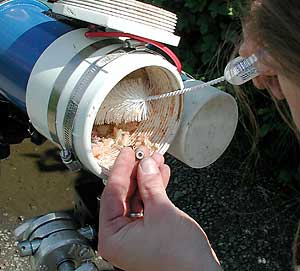
|
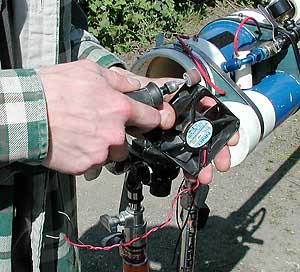
|
A duplicate NMB 80mm fan was installed at once. The quick disconnects from the old fan were twisted onto the new wires and taped in place. These backfire incidents are educational and demonstrate the vacuum effect created by the slug and the cooling of gasses behind it but enough already. The sun was dropping in the sky and there were still over 100 shots to record.
|
|
The barrel was cut at the next standard length which was a ratio of .3:1. The whole launcher was moved forward until the muzzle was again 2' from the chronograph and then realigned. Potatos were shot first at this length since starch already covered the inside of the barrel. Spuds were able to exit this 265" barrel at over 200 MPH. The inside of the barrel was slippery after shooting 6 spuds which was causing the first gasket slug fired to record an unusually high velocity. To remedy this problem, a wad of paper towels was shot through the barrel after each string of spuds to clear the starch and water.
|
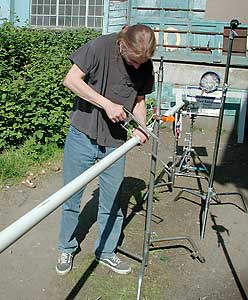
|
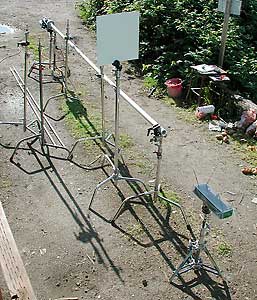
|
Once a routine was established, there was nothing left to do but shoot, reload and repeat. The test was proceeding similar to the earlier C:B test with the miniL1. Velocities were going up as the barrel became shorter and the shots with long barrels were nearly silent. Pictured here is a .5:1 ratio capable of 350MPH with spuds. The square card in the air is to keep direct sunlight off the chronograph sensors.
|
|
Velocities were recorded at a command center with all the conveniences of home. Consecutive shots proceeded at a steady pace even though the spuds would require extra time to cut and load. The catch bucket would have to be repositioned each time as it usually would flip in the air and fall to the ground. Gasket slugs load quickly but must be rescued from the plastic wrap after each shot. The same slug was used for this entire test but the gasket was replaced whenever a tear or defect appeared.
|
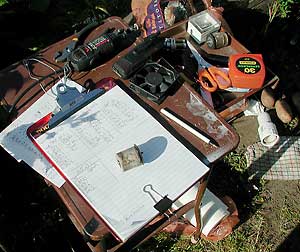
|
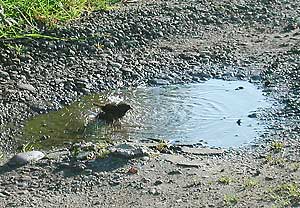
|
A little bird stopped by to check things out and to clean up in a nearby puddle. He asked all the typical questions. "What is that? How does it work? Why are you cutting it with a saw?" He then flew off muttering, "..tweetily frickin' doo..."
|
|
Pictured here is the L1 at .8:1, the anticipated fastest ratio. The spuds were coming in at 375 MPH while gasket slugs were recording as high as 430 MPH. The launcher at .8:1 was not silent but it was not unreasonably loud either.
|
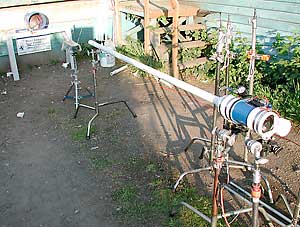
|
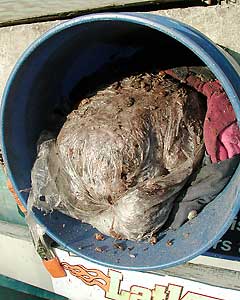
|
The bucket used to catch potatos was starting to show a little wear. It was getting heavy from all the spuds unable to escape. When a round would hit the plastic, it would disappear and the plastic wrap would knead over itself sealing the hole.
|
|
After six straight hours of shooting, everything started to look potato. Ah, the potatos. They were hand selected russets fresh from the grocer. Each was measured to fall between 1.75" and 2.125" in thickness. Two slugs could be occasionally be cut from one potato but most were cut from a single spud.
|
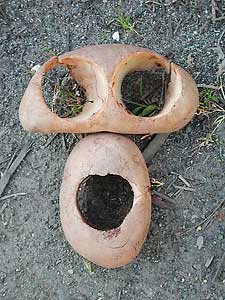
|
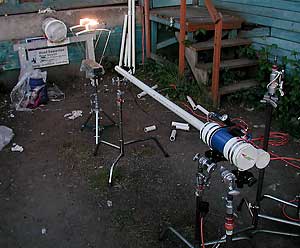
|
The sun had set but more shots were needed to complete the test properly. A lighting kit was added to the chronograph which continued recording each round. The spud bucket had blown completely apart by this time and more plastic wrap was added to the mess. The L1 is shown here a 1.3:1 which was producing a loud report. Earplugs were worn from here until the end of the test.
|
|
After the dust settled, we ended up with another 30' barrel in pieces. With the addition of a dozen channeled connectors, we could put it back together and do the whole thing again. Or use threaded connectors so it's collapsible, or...
|
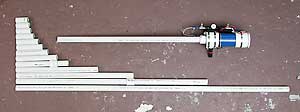
|
|
|
|